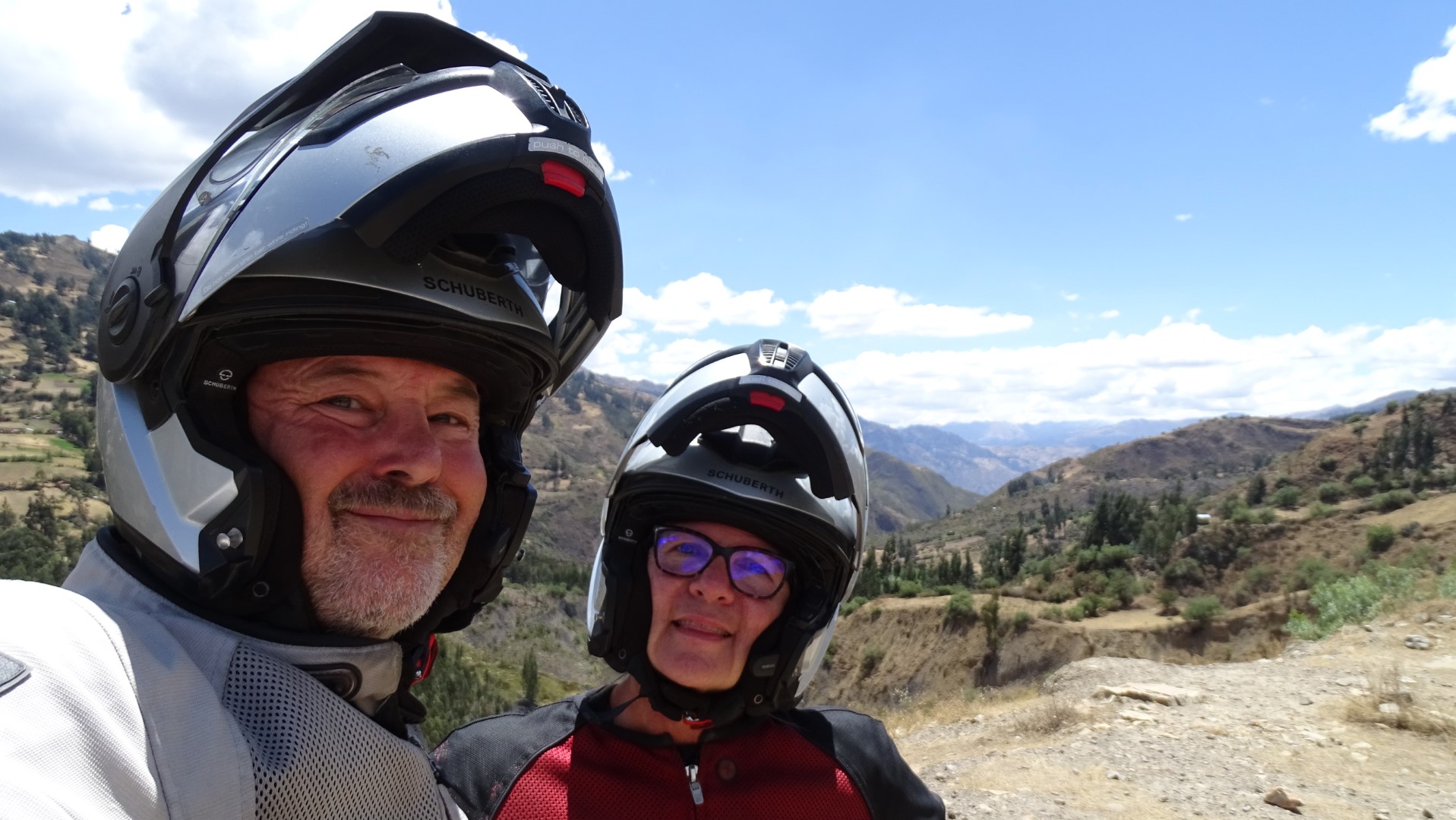Jim posting. I have read comments and observations in a other trip reports and blogs,…
An Eventful Day
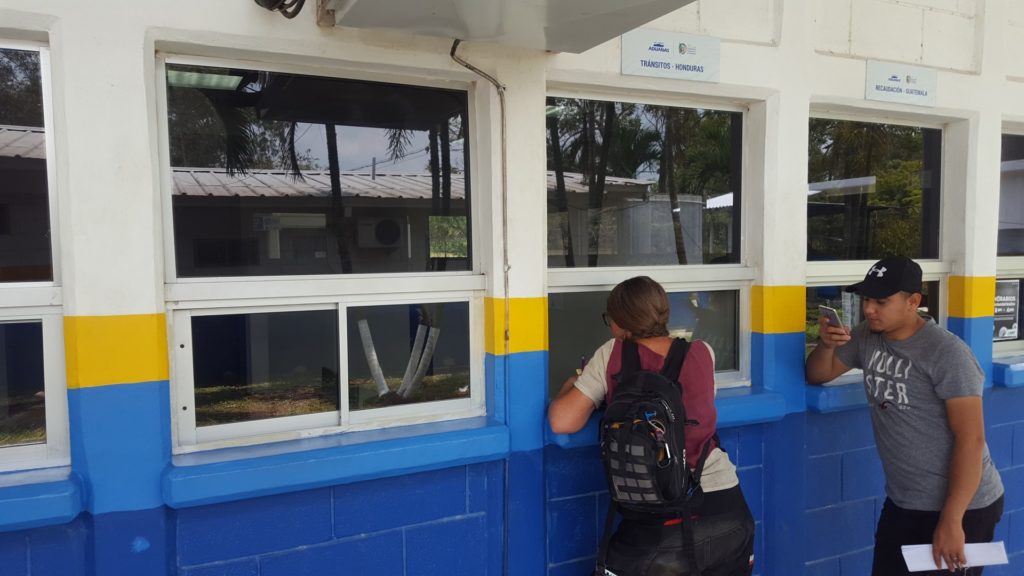
It was a border crossing day, which is always stressful. You know it will be eventful – you just don’t know the full extent of the events! We had decided to cross the Guatemala/Honduras border at a relatively quiet (we thought) crossing on Central America Hwy 13 (CA13), near the Caribbean coast. We were both hoping it would be simpler and quicker than the Mexico/Guatemala crossing we experienced three weeks prior – that was a nearly five-hour ordeal.
We left from the Dreamcatcher Eco Lodge on the Rio Dulce in Guatemala – a jungle lodge we had been at for four nights. Our motorcycles were parked at a marina; access to the lodge is by boat only. We got up early and caught the first boat shuttle at 7:00 AM, got to the marina and loaded up our motorcycles. It was already hot, and we had to wait outside for the 8:00AM opening of the marina store so we could pay our parking fee and get the receipt we needed to get out of the locked yard. Someone finally showed up and opened about 8:10AM, we paid and were on our way. We made a quick stop to fuel up in town, and then we were on to the border – about an hour and a half away. Traffic was not too bad – better than we had experienced the week before during Semana Santa.
We were riding on the Rio de Frontera (border road) and doing fine, passing mile after mile of banana plantations and almost no traffic. I thought “this is going to be a smooth border crossing!” Then, about 18km from the border, we ran into a line of stopped traffic, mostly semi-trucks. In my research, I had read something about bypassing the line of trucks when you get to the border, because they have a separate line for customs that is not used by other vehicles – so I thought maybe this was what was happening. But in the back of my mind I was concerned, because I was pretty sure we were too far from the boarder to have reached that line. But I told Carol “let’s go around them” – so we turned into the left lane (going wrong-way was no problem because there was almost no oncoming traffic) and drove past truck after truck, many carrying bananas or pineapples. There were a few other types of vehicles in between, but mostly semis. The drivers were mostly out of their rigs, socializing. Some had hammocks setup under their trailers and vendors had shown up and were selling food and water. They were obviously not expecting to go anywhere soon. As I’m taking all this in, I am increasingly sure this is not just an ordinary day at the border!
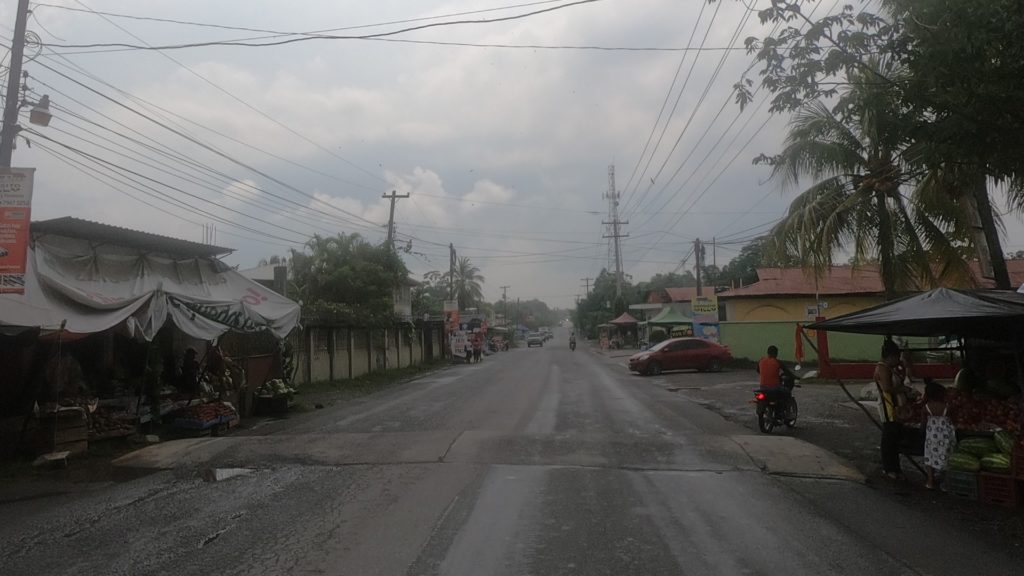
Village on the border road, Guatemala side. 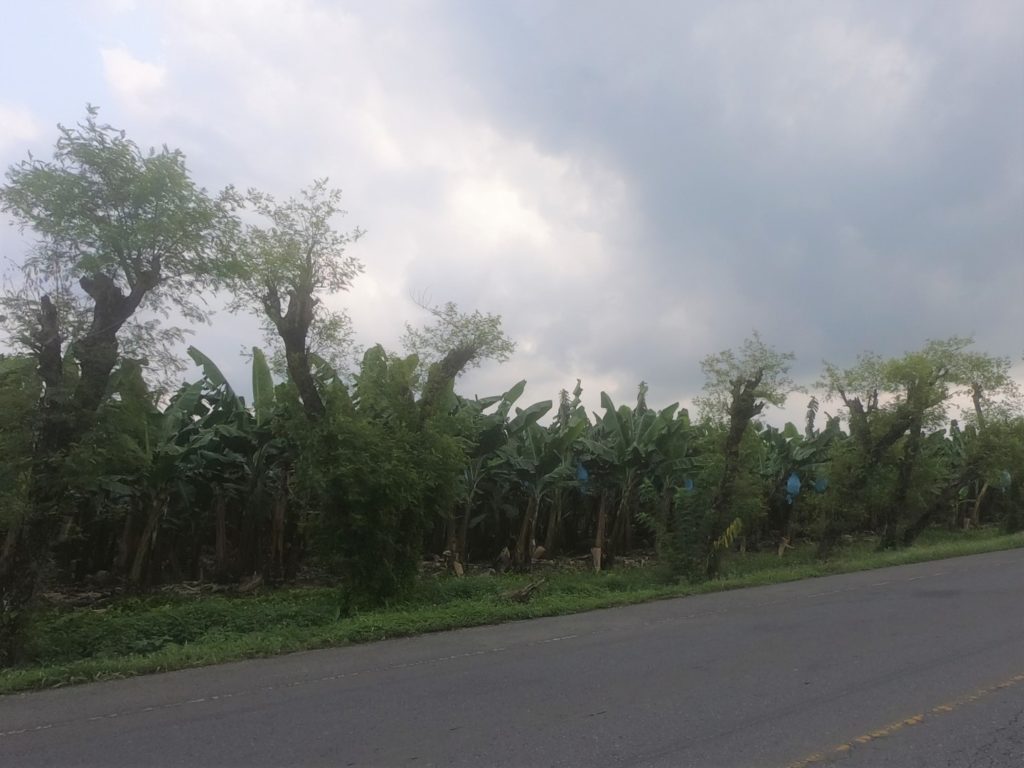
We passed mile after mile of banana plantations on the border road 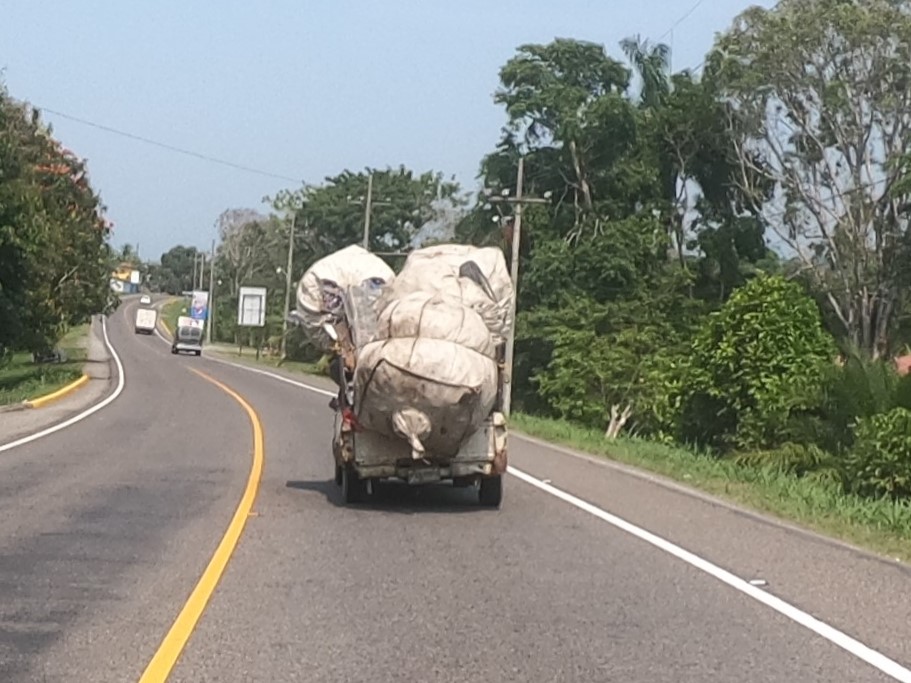
On the border road. I could make a gallery of overloaded vehicles we’ve seen
Bypassing the line of stalled vehicles was mostly straightforward, but sometimes we had to ride on the shoulder and/or squeeze by trucks that were trying to turn around. After about 2km of this, we finally came to the front of the line and found the cause for all this lack of motion – it was a protest blockade.
This is very common in Central America – the countries are very small (kind of like the states of New England in the USA) and the smooth flow of commerce across the land borders is economically crucial. Blocking the border halts that flow of commerce and gets attention – it is a staple of civic protest here. I do not fully understand how these things start and eventually resolve; the federal police were nearby, just as was the case at a similar blockade we came across in Mexico. But they were just sort of watching over the whole thing and doing nothing to intervene and stop the blockade. I get the feeling the officials allow it to go on for some amount of time – but if it continues for too long, they will act. I know that during last year’s protest in Nicaragua eventually the police or army broke down all the barricades. That was not a peaceful event, but most but these things do end peacefully as far as I can tell.
We pulled up to the front and parked on the shoulder next to the lead semi tractor-trailer, and I surveyed the situation. The physical blockade was some boards with nails and a few palm trees cut down and laying across the road. Nothing about the hombres hanging around the blockade seemed dangerous or threatening – they were serious but mostly smiling and seemed amiable; I sensed a generally good demeanor. I thought “Maybe I can get us across this!” I sort of felt challenged, to be honest. I knew they would be interested in us and our motorcycles, and I figured I could probably use Carol to play on their Latin sense of masculinity and chivalry. One thing I knew for sure: We couldn’t just hang around and wait to see what would happen. It was around 95 Fahrenheit, the humidity was through the roof and we were in full-dress motorcycle gear. Carol does not handle the heat well, and I knew I could not let her stand around in this heat for long (not to say I wouldn’t be feeling it as well!) Either I would get us through in short order so we could continue to Honduras, or we’d have to retreat and find a hotel back in Guatemala and try again another day.
I was parked on the shoulder at the front of the cab of the #1 truck, and Carol was back about 20 feet behind me, in the shade of the trailer it was pulling. As I took off my helmet and got off my bike a group of young men came over to check out the gringo and this monstrous motorcycle. I picked out one man that seemed to be a leader, and started talking to him in my poor Spanish, saying “Por favor señor, estamos solamente turistas en tus país, y necesitemos ir a Honduras”. He listened then said to me “El jefe habla ingles” (“the boss speaks english) and motioned me to follow him. Great, I think, the boss speaks English – that should help. He leads me to the boss, who was over on the other side of the truck, and then points towards the man apparently in charge, and says to me (in Spanish) “speak to him in English”. I am about to start talking, when the jefe looks at me and says, somewhat sternly, “No! Solamente español!” (“No – only Spanish!”) I honestly thought to myself “What – is this France? This guy speaks English but he’s not going to speak it with me! You bastard, I can play at this game.” His first card played just challenged me to win the game, and furthermore revealed that there was indeed a game to be played! So I said, with sort of a sigh, “Está bien, hablo español un poco.” (And that is true – I’m sure that the Spanish I’m writing here is pretty close to what I said, and I’m equally sure it is laden with bad Spanish grammar!) Then I laid it on – I took on (or at least tried to take on) a tired, humble and pleading tone and face, and said “Por favor señor, mi esposa y yo manejando dos motocicletas, y la clima está muy caliente. Estamos solamente turistas en tu país, y necesitamos ir a Honduras. Esta muy caliente, y mi esposa tienes calor. ¿Por favor, podemos ir?” Which is to say (more or less!) “Please sir, my wife and I are on two motorcycles and are just tourist in your country, and we need to go to Honduras. It is hot out, and my wife is hot (playing that angle!). Please, can we go?” I think he wasn’t happy that I spoke enough Spanish to force the dialog. He clearly understood me, but shook his head, kept his arms folded and said “No!” Sparing you my bad Spanish – I started in again, talking about how hot it was, and that my wife was overheating. I sort of pulled him around so he could see Carol, who by that time had gotten off her bike to get out water to douse herself (because she was overheating – I wasn’t lying!). When he could see her, I went at it again, and made sure he understood that Carol was riding her own motorcycle, and that she was getting overheated. That a woman is ridding such a motorcycle (huge by their standards) always impresses people here. After I made this last appeal, with Carol standing there, things turned in my favor! Not because the jefe had an immediate change of heart (and I honestly think he was just doing his job – it isn’t an effective blockade if you start letting people through). But the tide turned because of the reaction of his associates, who were standing around us listening to this exchange. They all started talking amongst themselves in Spanish, and I’m pretty sure the gist of the conversation was; “Come on boss, let the nice lady on the motorcycle go!” With popular sentiment turned against him, he reluctantly looked away from me, unfolded his arms and said “Ok”. Wanting to keep the momentum going in our favor, I quickly geared back up and got on my bike, and I told Carol to do the same. Then they moved a few of the trees so there was a navigable gap, and they let us pass! As we were going through the blockade, one of the men started to try and explain to us (in Spanish) what the blockade was about, something about workers not being paid equitably, I think. I sort of wished I had taken the time to stop and understand – but I was afraid that el jefe would have a change of heart, so we sort of said “thanks and goodbye!” and rode on.
The next 15 km to the border was a peaceful ride with no one else on the road! When we got to the border, I thought “this is going to be quick!” Maybe it was – I guess it depends on how you measure “quick”! People here talk about “Central American time” – it is a thing. Even with no one else to process (thanks to the blockade), it still took us two hours to get through.
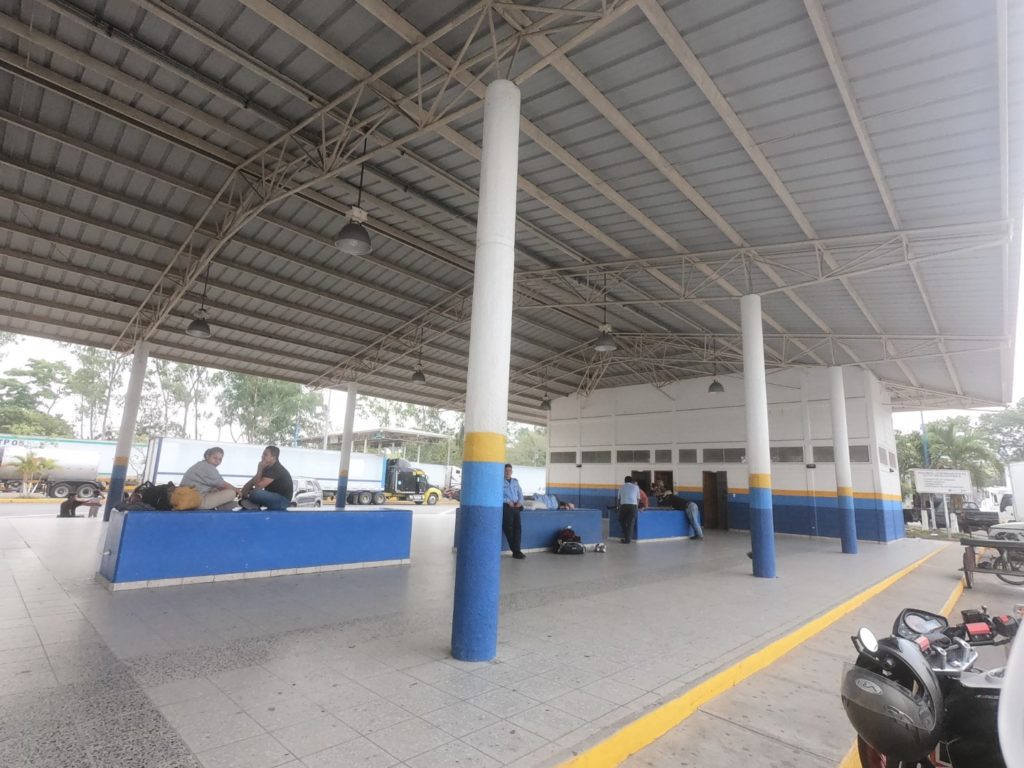
Getting across a land border is a multi-step process. First, you need currency for the country you are entering, so you can pay various fees. There are always money changes at the border, and you better know in advance what the current market exchange rate is for that day, so you can figure out how big a cut the changers are taking. You can haggle if you want – depends on how much time you want to spend. This time, the rate I was given for converting Guatemalan Quetzales to Honduran Lempira by the first changer I talked to was very reasonable, so I changed all the Quetzales I had into Honduran Lempira, except for the 20Q I knew I would need at Guatemalan customs office for our exit visas.
From a logistical/bureaucratic standpoint, the border crossing is a two-step process. First you have to “exit” the country you are leaving (Guatemala in this case) and then “enter” the country you are going into (Honduras in this case). But when you are bringing a vehicle along with you, things get complicated. Your physical person exits and enters through the respective immigration (migracion) offices and that part is generally not so bad. But our motorcycles need to exit and enter as well – and this requires going through customs (aduana) for both countries. Getting your vehicle across the border is the most time-consuming part, particularly the entry part of the process.
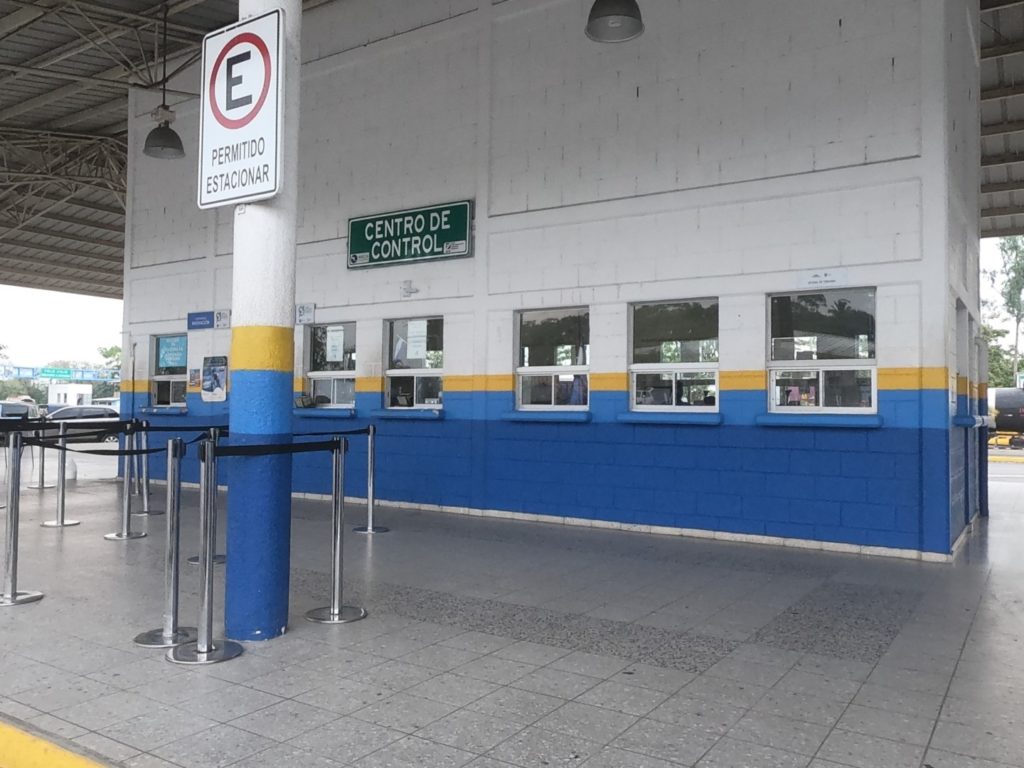
Exiting the country you are leaving is fairly straightforward – you wait in line, hand the bureaucrat some documents that you’ve (hopefully) carried with you since you entered that country. They check that over and eventually come out and verify your vehicle’s VIN number matches that on the paperwork, and then the rubber stamp comes out and blesses various documents, and you may pay an exit-fee. The process is more or less straightforward and not horribly time consuming.
But entering the new country is a pain. And the inefficiency! You need multiple copies of various documents (number and the type vary by country). For this purpose, we have a ready stash of copies of our passport, driver’s license, vehicle title and registration. But there are always one or more documents that you obtain as part of this process of which copies are needed, and you can’t prepare those in advance. This leads to one of the strangest and most inefficient aspects of the process: At this point you have waited in line to get to a bureaucrat, who prepares some paperwork and probably asks you to pay a fee, which may or not be legitimate (I just consider it a tip – not worth fighting over). You are then told that you need copies of some of these documents to continue. What would make sense at this point would be to have a copy machine in the customs office to make the needed copies (charge me for it – I’d gladly pay) and then continue the process. But it doesn’t work that way. You must leave and go somewhere else to get copies made, some private business near the border offices. This time, I was told that the place where I could get copies was so far away that I should ride my motorcycle to get there. So I left Carol at the border while I rode into Honduras (on the motorcycle that I am trying to get a Honduran import permit for!) to the green building on the left after you pass such and such (those were nature of the instructions I was given). I stopped in front of the long building that I thought was the right place, but there was no sign indicating “copies made here”. The building had multiple offices, and I wasn’t sure which to go into. A friendly local who spoke English saw me and asked what I was looking for, and when I told him he said yes, you could get copies (“copias” en espanol) here, and walked me to the correct office. The “copy machine” was an old Epson printer with a copy function – slow and very bad quality copies, but they didn’t say they needed good copies, just copies!
Copies in hand, I drove back to the border and the customs office, where we had to go to another window. No one else was in line and I was thinking “we’re almost done!” as I handed all of our paperwork to the young woman behind the window. She began typing things into some sort of form on her computer. Minutes go by. Occasionally she writes something onto the document that she is preparing (the actual import permit). She says she has to come out and see the motorcycle and shuts the window and walks to an outside door, where I meet her and we walk to Carol’s bike to record the VIN number. Then back to the office for more typing on the computer, staring at the computer, occasionally recording some information from the computer onto the permit. Occasionally, a wisp of air-conditioned air wafts out from the window – heavenly! I positioned Carol in front of the window to take advantage of this second-hand AC. Finally, after about 20 minutes (Carol swears it was longer), we are handed a vehicle import permit! But that was just for one motorcycle. Repeat the process and after another ~20 minutes we have the permits for both bikes, and finally, two hours after arriving and with no one else in line, we are free to go!
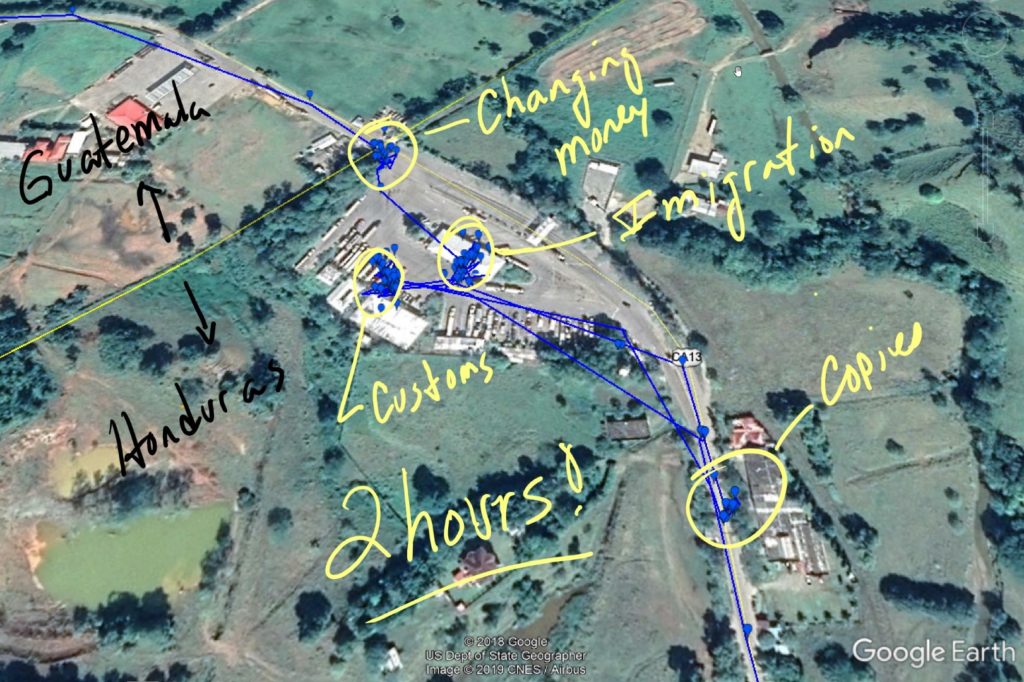
That is already enough events for a day – but the day is not over and there is more to come! We were happy to be moving again and headed on our way towards our intended overnight stop at the town of San Pedro Sula. But by now it is getting on towards lunchtime, and so after putting some miles between us and the border, I started looking for places to eat. We passed a nice-looking restaurant in the town of Omoa called “Family Restaurant” and so we did a u-turn and went back. There was a nasty drop-off from the road to the steep and short gravel parking lot, and Carol dropped her bike pulling to a stop! The parking attendant came over to help and we got her upright, parked and went in for lunch. The restaurant was in a beautiful setting, right on the ocean, and we both decided to try Conch, since it had been on the menu all along the Caribbean and neither of us had tried it yet. Big sea snail – neither of us were impressed, but we ate enough to not be hungry, paid and headed for the parking lot.
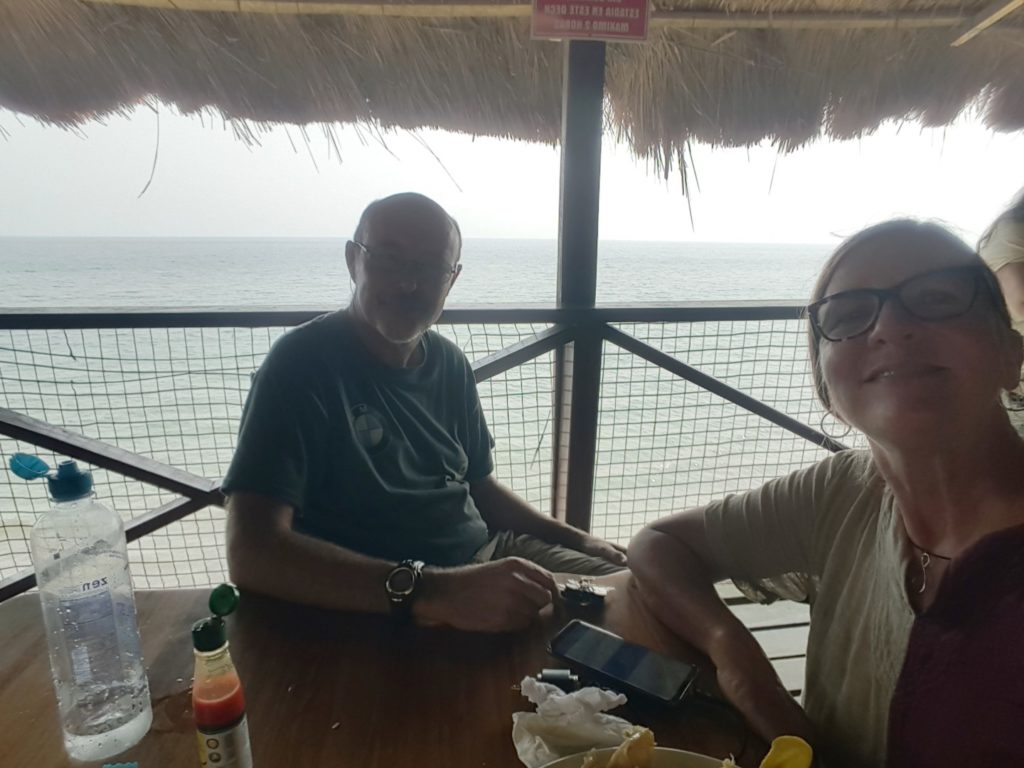
Because it was so hot, we had taken off our motorcycle jacket and over-pants for lunch (this will be important later), so it took us a bit to gear up. After getting my motorcycle over-pants on (but not my jacket – important detail), I told Carol “Let me get your bike turned around for you”. That way she would have an easier time getting out of the steep dirt lot and up onto the road. I did that, and then came back to my bike, put on my jacket, gloves and helmet, and we were off.
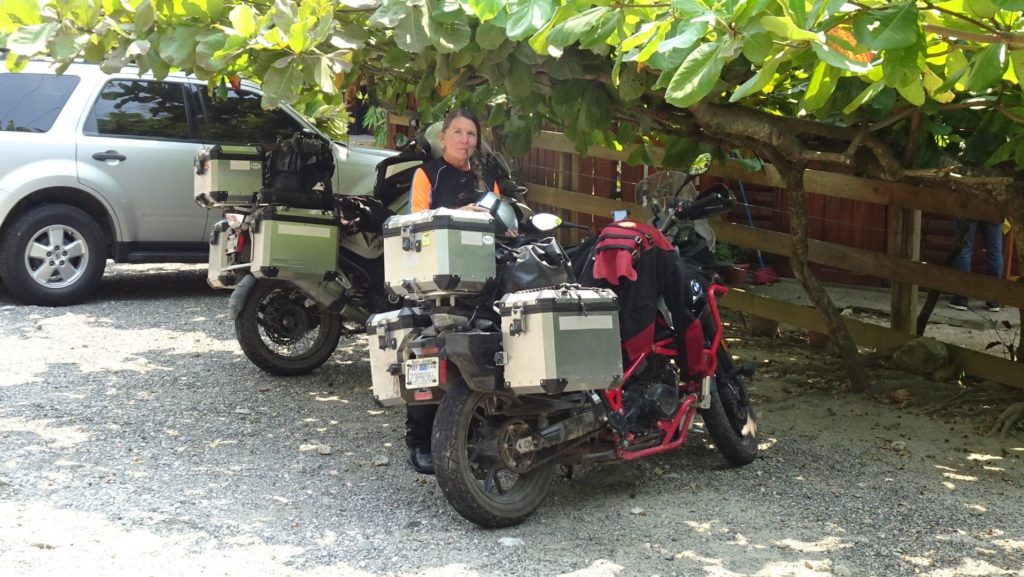
We rode on, and we were both impressed with the quality of road – the asphalt was in good condition and there were paved shoulders! Often on good roads like this, Carol will take the lead, and she did so here after about an hour of ridding. With her leading, my mind was freed up enough to suddenly think “where are my keys?”
My motorcycle has the unwelcome feature of a “keyless ignition.” I have never been a fan and I would pay money to have it removed and replaced with a traditional key if it were possible. In case you are not aware of how this works: In place of a traditional key that you put into the ignition switch, there is a “Fob” that uses RFID technology to signal to the ignition system that it is in the vicinity of the motorcycle and it is ok to start the engine. You then push a button and, assuming the Fob is nearby, the engine starts. The weakness in this system is in the “in the vicinity” aspect. The expectation is that the Fob is in your possession (e.g., your pocket). But I know from experience that if the Fob is on, say, the workbench next to the motorcycle, this is sufficiently “in the vicinity” to start the motorcycle. If you startup the bike with the key nearby but not on your person, and then drive off leaving the Fob behind, nothing notifies you of the fact. But when you stop the motorcycle later, it will not start again, because the Fob is not there. I have been dreading the possibility of this scenario the entire trip, and have developed a routine ritual of physically checking for my keys, wallet and phone every time I get on the motorcycle, chanting out loud “keys, wallet, phone” as I put my hand on each.
As I thought “where are my keys?”, I realized that I couldn’t remember doing this ritual check before we left the restaurant, and a quick pat of my jacket pocket did not reveal the familiar Fob-shaped bulge. This key ring holds more than just the Fob – it also has the key to my motorcycle luggage and several other locks that are part of my gear. Feeling a bit of panic, I told Carol we needed to stop, and we pulled over to the side of the road. I left my bike running while doing a thorough check of my jacket pocket; it is not there, nor is it in my pants pocket or tank bag. If the key is indeed missing and I stop the engine, it will not restart. But I have an emergency key, a plastic key with a non-powered RFID chip that can be used to get the bike going again with some effort. This is hidden on the bike, and I extract it from its hiding spot, and then I turned off the engine. I know that if it starts back up, that means that the Fob is there somewhere – either on my person or in my luggage or some other place on the bike. But … no go. It will not start – they key is indeed missing.
I retraced my actions back at the restaurant, and I realize that I broke routine when I went to move Carol’s bike. I put the keys in my pants pocket when we went into the restaurant. Usually I would have moved those to my jacket pocket right after I put on my over-pants. But at the restaurant I stopped after putting on my pants to move Carol’s bike. Thinking about the sequence of events, I was pretty sure I must have put the keys on top of my duffle bag when I was putting on my pants, and left them there when I went to move Carol’s bike, because I left my jacket off while I did that. Then, when I got back to my bike, I put my jacket on, but forgot about the keys. Since they were on the duffle bag, they were “in the vicinity” of the sensor and the bike started – and then the keys fell off.
I was pretty sure that this was what had happened, but the question was, where did they fall off? I was thinking that if I’m lucky, they fell off as I was pulling up onto the road at the restaurant. There was quite a ledge getting from the gravel curb to the asphalt, and I hoped that they fell off there, because if not they could have ended up anywhere along the way. The odds were not great that I could find them, but it wasn’t outside the realm of possibility either.
At this point we have a difficult decision; it is still really hot out, and we are only an hour away from the hotel where we were planning to spend the night. It would be a nearly two-hour round-trip detour to go back to the restaurant, and there was no guarantee that the keys would be there. Adding two hours of extra riding in this heat would tax her beyond her limits – it has been a long day by this point! She could go on to the hotel while I went back, but splitting up like that on our first day in a new country was not ideal, and we did not have reservations at this hotel, so there was no guarantee she would get a room. But we could communicate using our cell phones and losing all my keys was going to be a major issue. And there was a chance I could find them if I went back.
In the end we decided to split up. I made sure Carol had the Google-map directions to the hotel on her phone, and then I used my emergency key to get my bike running. The emergency key is awkward to use; you must hold it directly in contact with the RFID antenna under the rear wheel well with one hand, while reaching up with the other and pressing the start button. It is quite a contortion. But I got it started back up and then I headed back to the restaurant and Carol rode off in the other direction towards the hotel. I was not sure this was a good plan, but it seemed the best of the bad options.
I rode aggressively, retracing our route back to the restaurant, all the way I was alternately praying I’d find them and then imagining the steps and hoops I would have to go through to try and get a new Fob when I didn’t. I had read stories in online forums about how difficult it is to replace a Fob; BMW Germany is involved, it takes weeks and costs lots of money. And it would have to be done at a Central or South American BMW dealer where language barriers would extend in multiple directions, from Spanish to English to German.
When I got to within 10 miles of the restaurant, I started to carefully study the road for any sign of the keys. But there were many people walking on the road and I thought they would have been picked up. Or run over. Or bounced off the road into the bush. What are the odds! Finally, I arrived at the restaurant, and pulled down into that steep gravel parking lot. I got off my bike, started looking around on the ground where I had been parked and along the path I thought I had taken riding up onto the road. I couldn’t see them, so I thought I’d go ask inside if they had been found, and as I turned around to walk to the entrance, I saw walking towards me the waiter that had served us – he had seen me looking around through the window. And … he was holding my keys!!!
As he approached me and reached out to hand me my keys, I literally fell down on my knees and looked to the sky and said “thank you God!” He looked rather surprised, and I was full of emotion. I was worried about my decision to split up and leave Carol on her own, worried about the logistical aspects of continuing this trip w/o my keys and Fob, afraid to hope knowing the slim-to-none chances I would ever find them, and then… there they were! I had to use my phone translator app to try and explain to the waiter. I told him “Oré a Dios por estas llaves!” (I prayed to God for these keys!), and I also tried to explain how difficult it would have been for me if I had lost them. They had indeed fallen off my bike, and I presume the young man that was watching the parking lot found them – he was watching us as we took off and likely saw them fall as I rode away.
With keys in hand and my heart overwhelmed with relief, I jumped back on my bike and started it up – with my Fob and not the emergency key! Before I headed out, I took out my phone to send Carol a quick text message, saying “Keys found, on my way” I knew I would not get a reply while she was riding, but I hoped she would see it pop up on her screen as she was riding and be encouraged. And before I hit the road, I performed my ritual, “keys, wallet, phone” routine.
The rest of the day ended well and pleasantly uneventfully – Carol made it to the hotel on her own just fine, and they did have rooms available. When I got there, we headed to the pool to cool off, and then walked to the restaurant next door for dinner and then back to our air-conditioned room for a good night’s sleep. Sadly, we don’t have many pictures to document the events – we were too busy being “in the moment’ to stop and take any! But it was quite a day – and one I felt needed a full accounting for our own future remembrance and hopefully some vicarious enjoyment for you, the reader.
